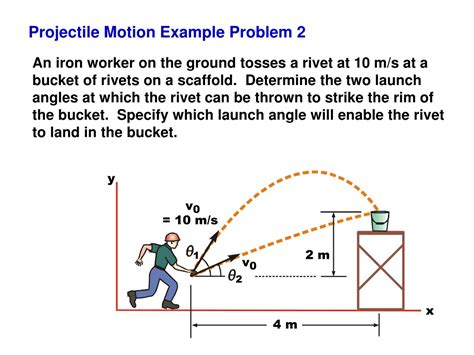Introduction
Projectile motion, the study of objects thrown or launched into the air, is a fundamental concept in physics. Mastering this topic requires a solid understanding of kinematics and the ability to apply equations to real-world scenarios. This article presents a comprehensive collection of practice problems designed to enhance your projectile motion skills.

Kinematic Equations for Projectile Motion
The key kinematic equations used in projectile motion are:
- Horizontal Displacement: Δx = v₀t
- Vertical Displacement: Δy = v₀t – 0.5gt²
- Vertical Velocity: v = v₀ – gt
where:
- v₀ is the initial velocity
- t is the time elapsed
- g is the acceleration due to gravity (approximately 9.8 m/s²)
Practice Problems
1. Basic Projectile Trajectory
A ball is thrown horizontally from a height of 20 meters with an initial velocity of 10 m/s.
- (a) Calculate the time it takes for the ball to hit the ground.
- (b) Determine the horizontal displacement of the ball when it hits the ground.
- (c) Compute the velocity of the ball just before it hits the ground.
2. Maximum Height of a Projectile
A rocket is launched vertically upward with an initial velocity of 100 m/s.
- (a) Find the maximum height reached by the rocket.
- (b) Calculate the time it takes for the rocket to reach its maximum height.
- (c) Determine the velocity of the rocket at its maximum height.
3. Range of a Projectile
A projectile is launched at an angle of 45° with an initial velocity of 50 m/s.
- (a) Compute the horizontal range of the projectile.
- (b) Calculate the maximum height reached by the projectile.
- (c) Determine the time of flight of the projectile.
4. Velocity Components of a Projectile
A ball is launched at an angle of 60° with an initial velocity of 20 m/s.
- (a) Find the horizontal and vertical components of the initial velocity.
- (b) Calculate the velocity of the ball at the highest point of its trajectory.
- (c) Determine the angle at which the ball is launched when it returns to its original height.
5. Projectile in a Uniform Electric Field
A proton is launched horizontally from a point 0.1 meters above a positively charged plate. The potential difference between the plate and the proton is 100 volts. The initial velocity of the proton is 1000 m/s.
- (a) Calculate the electric field strength between the plate and the proton.
- (b) Determine the horizontal displacement of the proton when it hits the plate.
- (c) Compute the time it takes for the proton to hit the plate.
Common Mistakes to Avoid
- Forgetting to include the acceleration due to gravity in the vertical equations.
- Using the same initial velocity for both the horizontal and vertical displacement equations.
- Ignoring the sign of the vertical velocity when determining the time of flight.
- Assuming that the projectile has the same horizontal velocity throughout its trajectory.
- Neglecting air resistance in realistic projectile motion problems.
FAQs
-
What is the range of a projectile launched at a 45° angle?
– The range is equal to twice the maximum height reached by the projectile. -
How can I determine the time of flight of a projectile?
– The time of flight is twice the time it takes for the projectile to reach its maximum height. -
What is the effect of air resistance on projectile motion?
– Air resistance slows down the projectile and reduces its range and maximum height. -
Can projectile motion be used in real-world applications?
– Yes, projectile motion is applied in fields such as ballistics, rocketry, and sports. -
What is the difference between a projectile and a satellite?
– A projectile eventually returns to the ground, while a satellite orbits the Earth or another celestial body. -
How can I improve my projectile motion skills?
– Practice solving problems regularly, and don’t hesitate to consult resources like textbooks and online tutorials.
Conclusion
Mastering projectile motion requires a solid understanding of the kinematics equations and the ability to apply them to various scenarios. The practice problems presented in this article provide ample opportunities to hone your skills. By addressing common mistakes and exploring real-world applications, you can expand your knowledge and develop a deeper appreciation for this fundamental concept in physics.
